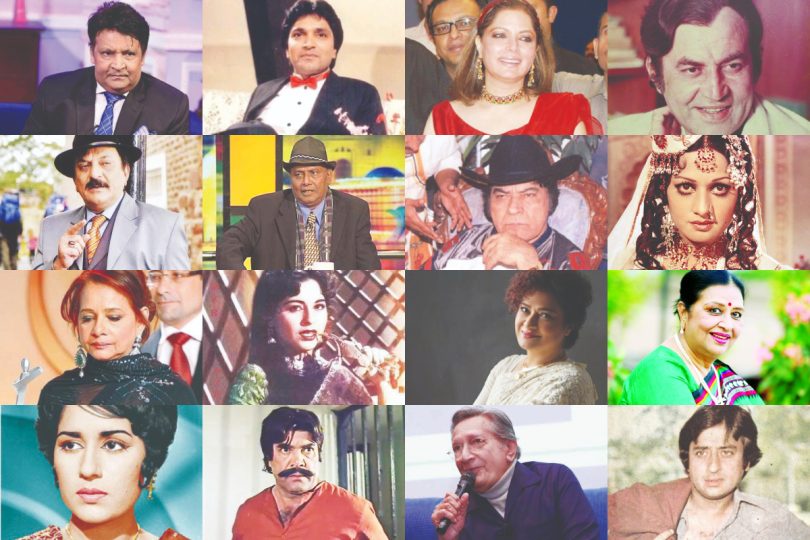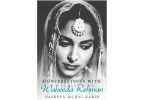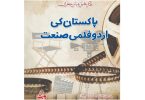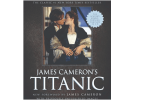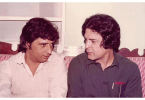On the occasion of Pakistan’s 75th Independence Day, BOLD pays tribute to those 30 personalities whose acting prowess made the country famous all over the world
Although Pakistan’s first film Teri Yaad released just one week before the country’s first birthday, and TV came into the lives of Pakistanis in 1963, actors from both these platforms (as well as Radio and theatre) compensated for lost time by delivering performances that are still considered iconic around the world. BOLD pays tribute to 30 such individuals who came, who performed, and who conquered, be it in films, TV, or theatre and their feats are nothing short of legendary.
The men who ‘lead’ the way in films!
Pakistan’s film industry has produced some of the greatest actors who have dominated the screen for the most part of their careers, but it all began in the 1950s with Sudhir, the first film star, who was at ease when doing drama and action. He may have made his film debut in the year of Independence, but he went on to deliver countless hits in the newly created country. From the late 1940s till the 1960s, Sudhir was the leading man who had no equal and even continued to act in films till the 1980s, gelling well in films alongside younger actors.
Whenever the history of Pakistani films would be written, the name of Allaudin would be there at the top because he was among the first scene stealers in the industry. He may have been senior to Sudhir since he debuted in films in the early 1940s, he was more into character acting than acting as a lead, although he was comfortable anywhere, as long as it was in front of the camera. He continued to act in films till the 1980s and offered more to Pakistani cinema than just Kahan Se Aaye Hain Yeh Jhumke scene.
The 1960s saw the arrival of three young leading actors who would go onto shape the future of cinema in the country. Mohammad Ali was tall, dark and handsome one from the group who became popular for his towering personality, his ability to deliver dramatic performances at the drop of a hat, and taking forward the action star persona that began with Sudhir. Waheed Murad was the eternal chocolate hero who introduced synchronized dancing to Pakistani films, was successful as a producer before making his debut as an actor and then became the country’s heartthrob because of the way he romanced on screen and filmed songs that were way ahead of his times.
And then there is Nadeem, undoubtedly Pakistan’s longest-serving leading man who may have been junior to Mohammad Ali and Waheed Murad, but who continued to shine after the others bid adieu to the film arena. Had it not been for Nadeem’s evolution in the 1980s, Pakistani cinema might not have been able to revive time and again, and even after six decades, he is still considered a bankable actor who can draw the audience inside the theatre with his youthful persona. Along with Nadeem, it was Sultan Rahi who dominated the film industry in the 1980s and the 1990s before his assassination that shook the film industry in the country. He began his career as an extra, did supporting characters in the early part of his career, and then switched to an action star persona that helped cinema and filmmakers alike. He was comfortable in both Urdu and Punjabi cinema and ruled the box office when Double Version (Punjabi films dubbed in Urdu or vice versa) were a rage till the mid-90s.
The strong women who ruled the screen!
Although it was Noor Jehan who was undoubtedly the biggest star who dominated the screen in the early days of Pakistan’s film industry, Sabiha Khanum was the country’s first female superstar who evolved from a leading lady in the 1950s to a supporting actor in the late 1960s, and finally, character actor in the 1970s and 1980s, sharing her experience of working in films, later to the TV till the 1990s. Not only was her beauty unmatched, but she also formed the perfect pair with her husband Santosh Kumar who had a dashing personality. Shamim Ara belonged to the generation that succeeded Sabiha Khanum and was considered the most successful film actress between the 1950s and the 1970s. She first turned to production in the 1960s before venturing into film direction in the late 1970s, and for three decades she kept churning films that kept the industry alive.
The 1960s saw the rise of three young actresses who went to carve out separate identities for themselves; Zeba Begum, Rani, and Shabnam. While Zeba Begum made her debut in the early 1960s, Rani came to prominence in the 1970s while Shabnam kept churning hit after hit from the 1960s till the 1990s. Zeba Begum who married fellow actor Mohammad Ali in the late 1960s excelled as an actress who had the looks to kill, Rani’s graceful persona and dancing prowess was unmatched while Shabnam was an amalgamation of a brilliant actress who could dance better than many.
Although Babra Sharif debuted in a film as the second lead to Shabnam in the early 1970s, she went on to dominate the film screen for two decades. She began and ended her career on TV but in between, worked with nearly all the male leads in the film industry, including Mohammad Ali, Waheed Murad, Nadeem, Shahid, Ghulam Mohiuddin, Asif Raza Mir, Faisal Rehman, and Ayaz Naik. The generation that grew up in the 1970s and the 1980s still believes that Babra Sharif had no match when it came to elegance, for she lived in their hearts and minds.
Film actors who excelled at comedy!
Ever since directors have understood to have an actor in a film who would be able to break the tension between scenes, some actors have thrived on doing just that. The most famous name to make the audience laugh out loud is undoubtedly that of Lehri who remained a constant feature in films between 1960s and 1980s. He began his career as the sidekick who always got his friend in or out of trouble in films before migrating to character roles; his ability to ad-lib dialogues made him the favourite of audiences all over the world.
It wouldn’t be incorrect to say that the time between 1965 and 1975 belonged to Rangeela and Munawwar Zarif who were so hilarious that it made the audience go hysterical. It was one thing being unbelievable together, but also in films where they were cast alongside other actors, they stole scenes without trying too hard. They are the only actors who worked in a film that had their names in the title – Rangeela Aur Munawwar Zarif – which is something not many can claim to have done in their careers. After Munawwar Zarif’s untimely death in 1976, Rangeela and Rafi Khawar Nanha carried the torch for another decade before the latter left his fans saddened by taking his own life. Unlike his film contemporaries, Nanha was also famous on TV as Noon of the famous TV series Alif Noon who used to criticize the workings of society while his partner Allan (played by Kamal Ahmed Rizvi) tried to con the customers, each week.
Leading men who helped TV become popular
Pakistan Television would remain indebted to some of the actors for their brilliant performances, mostly as leading men, over the years. Be it Shakeel who focused on TV after not making it big in films or the technically sound Talat Hussain who made a name for himself as an actor wherever he went, PTV benefitted more from these actors than these actors benefitted from PTV. The 1970s saw the resurgence of Rahat Kazmi and Saleem Nasir who were integral to the success of TV dramas in the country. While Rahat Kazmi had a stint in films as well, Saleem Nasir gave memorable characters to his fans that are still popular three decades after his death.
The 1970s and the 1980s belonged to Abid Ali and Shafi Mohammad who gave a new direction to lead acting on TV. The versatile actors dominated the proceedings in Lahore and Karachi respectively and although Abid Ali turned to production when private TV channels entered the arena, Shafi Mohammad stayed loyal to the TV till death did them apart. He did work in a handful of films but was more at ease on TV, unlike Qavi Khan who was at ease in both platforms. He has been around ever since TV began its innings in Pakistan and has entertained the audience for generations, something that can’t be said for many actors in the country. Although his film career is also quite noticeable, he remains more of a TV actor where his presence adds colour to the screen.
Television’s leading ladies who raised the bar
It may be a man’s world but a handful of leading ladies have managed to create a separate identity for themselves on the smaller screen. Without any doubt, Uzma Gillani is one big name that has been around since 1970 and has constantly raised the bar with each performance. She has been cast as the heroine, done wonders in a character role, and even played supporting characters, always breathing life into the character. Roohi Bano was another actress who features on the favourite list of every Pakistani because she knew how to fulfil the demands of her characters. She may only have been active in 1970s and 1980s, but her body of work was so incredible that it keeps on inspiring youngsters who follow her into acting.
Another name that enhanced TV’s class was Khalida Riyasat who kept on giving hits before her untimely death at the age of 43. From the late 1970s till the mid-1990s, the actress remained on top of her game and was at ease whether it was a romantic character, a comic one or one where the performance had to be melancholic. She shared the screen with one Sania Saeed in her final play Ab Tum Ja Sakte Ho who seems to be carrying forward the legacy of these wonderful actresses in modern times. She began her career in the late 1980s and is currently in her fifth decade as a performer, winning hearts all around be it on stage, on TV, or in films.
Those who set the stage (and screen) on fire!
And finally, something about those comedians who spread laughter wherever they went and didn’t need films to raise the stakes. Although many came onto the scene before Moin Akhtar, the comedian dominated the game from the 1980s till his death forty years later. He began his career as a stand-up comedian of repute but evolved into Pakistan’s number one showman who could do no wrong. He partnered with Anwar Maqsood in such a way that their Loose Talk clips are still appreciated even more than ten years after Moin’s demise.
From mimicking fellow artistes as well as foreign ones, performing on Saturday Night Live style shows, and being the loose cannon on TV shows including Show Time, Commercial Time, Studio Dhai, and Studio Pawney Teen, he even acted on TV and in films but was known to the younger generation for his exploits as master of ceremonies, which was another feather on his cap. He inspired a lot of artistes to take up comedy, most notably Umer Sharif, who went on to carve a separate identity for himself due to his comedy timing, his humorous stand-up acts, and relatively successful film career. Not only did he revive theatre as a writer, director, and actor in his own country, but his style was also copied across the border and even today actors like Govinda, Akshay Kumar, and Kapil Sharma credit him for their success.
And then there was Amanullah Khan, the man who singlehandedly kept the Punjabi theatre alive with his unique style of comedy that was carried on by his students and those whom he inspired. Although he had a non-existent film career (only two films throughout his career), he had the ability to set the stage on fire with his humorous lines that seemed to come out from nowhere. He was considered as huge in Lahore as Umer Sharif in Karachi, and his stage shows are still popular in Pakistan, India, and wherever Urdu and Punjabi are spoken.

